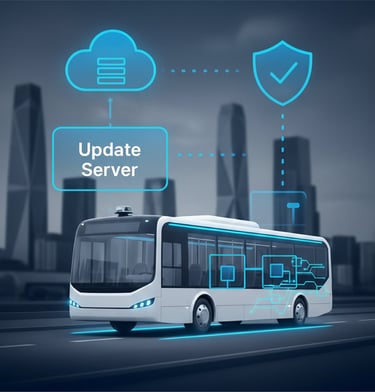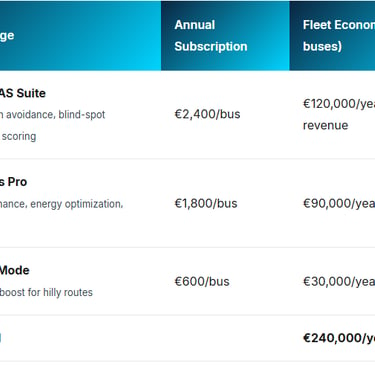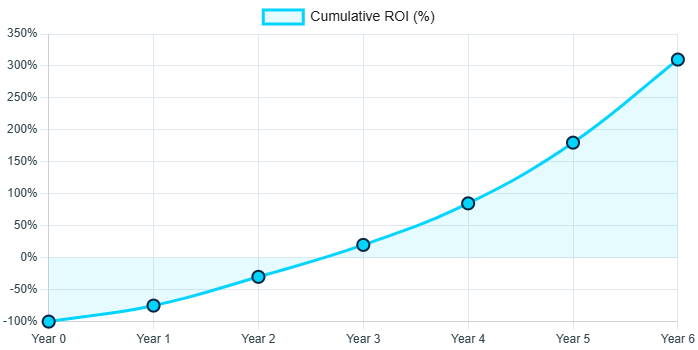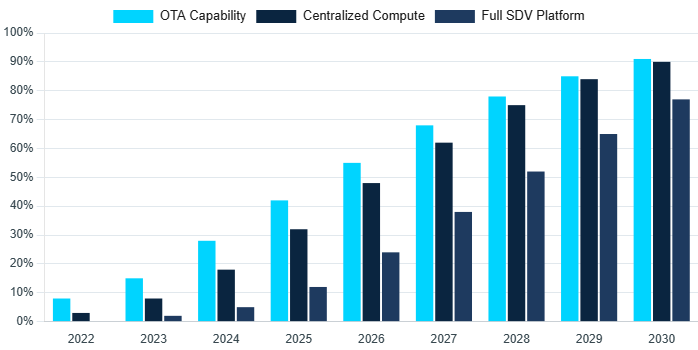OTA Updates for Bus Fleets: Best Practices, Security & Deployment Strategies
Discover best practices for over-the-air (OTA) updates in bus fleets. Learn secure deployment strategies, testing frameworks, compliance standards, and future trends for software-defined vehicles (SDVs).
SDV


"Keeping Your Fleet
Connected
Secure, and Always
Up-to-Date."


Gothenburg, Sweden — October 2023: At 2:47 AM, while the city slept, 47 Volvo 7900 electric buses received a silent software update. No technician touched the vehicles. No parts were replaced. Yet when drivers started their morning routes, something remarkable appeared on their dashboards: 12% more range on identical routes — same 350 kWh battery pack now delivering 42 additional kilometers.
This wasn't magic. It was software-defined vehicle (SDV) architecture in action. The update optimized battery thermal management algorithms, adjusted regenerative braking profiles, and refined motor control strategies, Same hardware, Smarter software.
While Tesla popularized over-the-air (OTA) updates in passenger cars, the bus industry is undergoing its own quiet revolution. But the stakes are exponentially higher: a failed update on a city bus doesn't just inconvenience one driver — it strands 60 passengers and disrupts an entire transit network.
This is why bus manufacturers approach SDV with both urgency and extreme caution. Get it right, and you can continuously improve vehicles throughout their 12-15 year lifespan. Get it wrong, and a single bad software deployment could brick an entire fleet, costing millions in service disruptions.
What Makes a Bus "Software-Defined"?
Let's be clear: SDV is not just OTA updates. That's like saying a smartphone is just wireless downloads. The architecture runs much deeper.


Core Components of SDV Architecture








Centralized Computing Platform
High-performance processors (200+ TOPS) replace dozens of distributed ECUs. Think: vehicle supercomputer vs. calculator network.
🧠
Standardized E/E Architecture
Automotive Ethernet backbone (1 Gbps+) replaces fragmented CAN/LIN networks. One language for all systems.
Continuous Update Capability
Secure OTA pipelines deliver software updates, security patches, and new features remotely.
Software-Defined Features
Vehicle capabilities unlocked via code, not hardware swaps. Subscription-based ADAS, performance modes, analytics.
🔌
📡
🎨
Definition: A Software-Defined Vehicle leverages centralized computing, standardized electrical/electronic (E/E) architectures, and over-the-air capabilities to enable continuous feature evolution throughout the vehicle's lifecycle — without hardware modifications.
Why Bus OEMs Are Betting Billions on SDV
(Right Now)








€12.5B
Combined SDV R&D
Investment (2023-2028)
60%
New buses with SDV features by 2030
-35%
Combined SDV R&D
Investment (2023-2028)
+200%
Software engineers
hired 2022-2024
1. Operational Flexibility & Mass Customization
Consider two transit agencies with opposite needs :




Case Study: Berlin vs. Stockholm
Berlin Urban Transit:
• 120 stops per route, 18-hour service days
• Door cycle algorithms optimized for 8,000+ open/close cycles per day
• Battery management prioritizes fast charging (15 min opportunity charges)
• Passenger counting for dynamic route capacity planning


Stockholm Intercity Coaches:
• 400 km routes in -20°C winters
• Battery thermal preconditioning critical (35% range impact if not managed)
• Energy recovery from cabin heating systems
• Predictive range calculation accounting for weather, terrain, load
Traditional approach: Two completely different vehicle platforms. Development cost: €80M+ each.
SDV approach: Same hardware platform, different software configurations. Shared development cost: €95M total. Savings: €65M (40%)
2. Revenue Model Transformation
SDV enables subscription-based monetization — a seismic shift from one-time vehicle sales:


10-year fleet lifecycle value: €2.4M in software revenue vs. €0 in traditional model. This is why Daimler Buses created a dedicated software subscription unit in 2023.
3. Regulatory Compliance at Speed
Regulations evolve. Hardware doesn't. This mismatch has historically cost OEMs millions in recalls.
Example: EU Cybersecurity Mandate (UN R155, effective July 2024)
Requires intrusion detection, secure boot chains, and vulnerability management. For a traditional bus:
Hardware retrofit: €8,000-€15,000 per vehicle
Service downtime: 3-5 days per bus
Fleet-wide recall: 6-12 months
For an SDV bus: Software patch deployed overnight. Zero downtime. Compliance achieved in 48 hours fleet-wide. Cost: ~€200/vehicle (engineering + validation).


SDV Platform Investment Return Timeline
The Technical Gauntlet: Why SDV is Harder Than It Looks


The Legacy Integration Nightmare
A modern 12-meter urban bus contains subsystems from 15-25 different suppliers. The HVAC speaks one protocol. Door controllers use another. Lighting? Yet another.
Real cost: Daimler eCitaro needed custom gateway ECUs (€1,200/vehicle, 3.5kg added weight) to bridge legacy HVAC with Automotive Ethernet
Timeline impact: Middleware development added 9 months to platform launch
Ongoing burden: Gateway ECUs require separate software maintenance cycles




Cybersecurity: The 2AM Phone Call
Near-miss scenario (2021, European agency): Fleet management system compromised via contractor phishing. Attackers gained OTA update server access. If they'd deployed malicious code, 340 buses could have been disabled during rush hour.
Prevented loss: €15M+ (service disruption, emergency rentals, reputation)
Required defenses: Hardware Security Modules (~€45/bus), end-to-end encryption, intrusion detection systems
Compliance mandate: UN R155/R156 now legally required in EU
Validation Complexity Explosion
Traditional bus: Test 50-100 hardware configurations
SDV bus: Test 50 hardware × 200 software configs = 10,000 permutations
HIL testing investment: Volvo Buses spent €8M on Hardware-in-the-Loop infrastructure for next-gen SDV platform
Timeline extension: 6-9 months added to development cycles
Solution: AI-driven test prioritization (reduce test cases by 60% while maintaining coverage)
Who's Leading (and Who's Catching Up)
Front-Runners
Volvo Buses: €2.5B SDV investment (2023-2028). Next-gen platform features NVIDIA Drive compute (254 TOPS), zonal E/E architecture, and full AUTOSAR Adaptive implementation. First production vehicles: Q4 2025.
Key innovations: Over-the-air updates for safety-critical systems (first in industry), AI-powered predictive maintenance integrated at platform level, digital twin technology for virtual validation reducing physical testing by 40%.
Daimler Buses (EvoBus): eCitaro electric platform already features OTA updates for battery management and vehicle control systems. 2,800+ buses deployed with remote update capability. Subscription services launched in 2024: Fleet Analytics Pro (€1,800/bus/year).
Strategic advantage: Leveraging Mercedes-Benz automotive SDV experience. Cross-pollination between car and bus divisions accelerating development. Integration with Mercedes-Benz User Experience (MBUX) for unified software ecosystem.
BYD: Leveraging automotive SDV experience from passenger cars. K9 electric bus integrates advanced telematics, predictive maintenance, and cloud-connected battery optimization. Strong presence in Asia-Pacific, expanding to Europe.
Market position: Vertical integration advantage (batteries + power electronics + vehicles). Proprietary BYD cloud platform with 50,000+ connected vehicles globally. Focus on total ecosystem control vs. open platforms.
Fast Followers
Scania: Announced SDV strategy Q2 2024. Partnering with Continental for zonal controllers. Target: 2027 production launch. Investment: €800M through 2028.
Approach: Modular platform strategy — same SDV architecture across buses and trucks. Sharing development costs with commercial vehicle division. Focus on open APIs to build supplier ecosystem.
MAN Truck & Bus: Focus on commercial vehicle SDV ecosystem. Beta testing OTA updates on Lion's City E fleet (Munich, Hamburg). Collaboration with Siemens on cybersecurity framework.
Timeline: Full SDV platform launch 2026. Currently in validation phase with select transit agencies. Emphasis on safety certification (achieving ISO 26262 ASIL-D for safety-critical updates).
Solaris: Partnership with Bosch for centralized vehicle computer. Testing began Q3 2024 in Warsaw fleet. Target: 50% of new deliveries SDV-capable by 2027.
Strategic Partnerships
Recognizing the complexity, OEMs are forming strategic alliances:
Volvo + NVIDIA: Joint development of centralized compute platform (DRIVE AGX Orin)
Daimler + Continental: Co-development of zonal architecture and domain controllers
Scania + Ericsson: 5G connectivity and edge computing for real-time updates
Industry-wide AUTOSAR consortium: Shared software platform standards to prevent fragmentation


SDV Feature Adoption in New Bus Deliveries


SDV Development Cost Breakdown (Typical 12m Electric Bus Platform)
What This Means for Your Business
For OEMs & Suppliers
Invest in software talent: Automotive OEMs increased software engineering headcount by 200% (2022-2024). Bus manufacturers must follow suit.
Adopt agile methodologies: Traditional 24-month development cycles incompatible with software-defined features. Move to 6-12 week sprint cycles.
Build cybersecurity from day one: UN R155 compliance isn't optional. Budget €500k-€2M for CSMS (Cyber Security Management System) certification.
Rethink supplier relationships: Demand open APIs, standardized interfaces. Proprietary protocols are SDV roadblocks.
For Fleet Operators & Transit Agencies
Specify SDV capabilities in RFPs: OTA update infrastructure, API access for third-party apps, data ownership clauses.
Budget for subscriptions: Future TCO includes annual software licenses (€2,000-€5,000/vehicle/year).
Develop IT/OT integration: SDV buses require network connectivity, backend infrastructure, cybersecurity monitoring.
Train maintenance teams: Software debugging skills now as critical as mechanical repair. Invest in upskilling programs.


Key Takeaways
SDV is inevitable: By 2030, 60% of new buses will feature software-defined capabilities. The question isn't "if" but "how fast."
It's more than OTA: True SDV requires centralized compute, standardized architecture, and continuous software lifecycle management.
Business model shift: Vehicle sales become platform sales. Recurring software revenue transforms OEM economics.
Technical challenges are real: Legacy integration, cybersecurity, and validation complexity require significant investment.
Competitive advantage is software: Future differentiation comes from code quality, update frequency, and feature innovation—not just mechanical engineering.
Partnerships are essential: No single company can master hardware, software, cloud, and AI alone. Strategic alliances accelerate development.
Operators gain leverage: SDV enables multi-vendor ecosystems, reducing dependency on single OEM platforms.
The Transformation is Irreversible
The shift from mechanically-defined to software-defined buses isn't a trend—it's a fundamental restructuring of the industry. Within a decade, the competitive landscape will be unrecognizable.
The bus is no longer just a vehicle that moves people from A to B. It's a mobile computing platform that happens to carry passengers. The sooner the industry internalizes this, the faster we'll realize SDV's transformative potential.
For operators, the message is equally clear: your procurement criteria must evolve. The lowest bid on hardware is meaningless if the software ecosystem is closed, the update strategy is vague, or the cybersecurity posture is weak.
The question isn't whether to embrace SDV. It's whether you'll lead the transformation or scramble to catch up.
